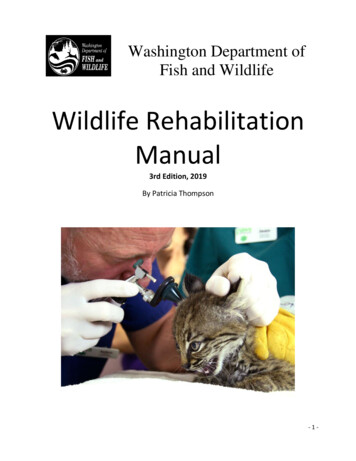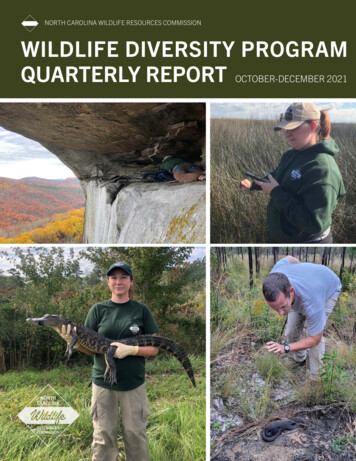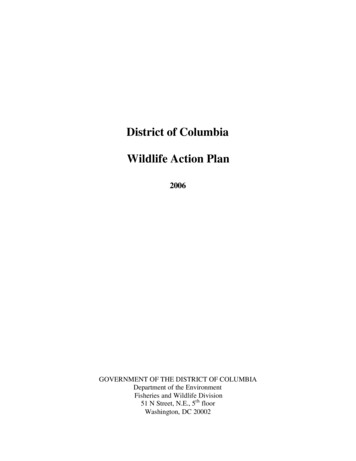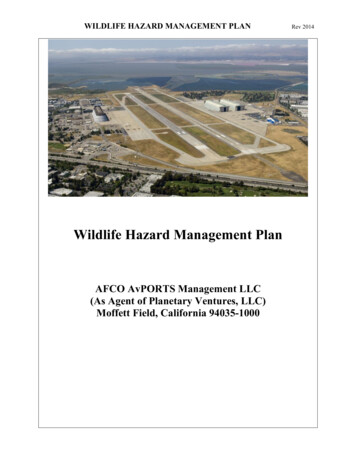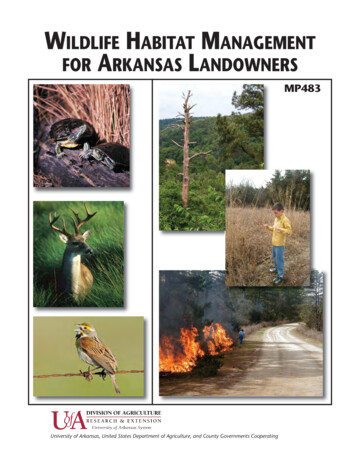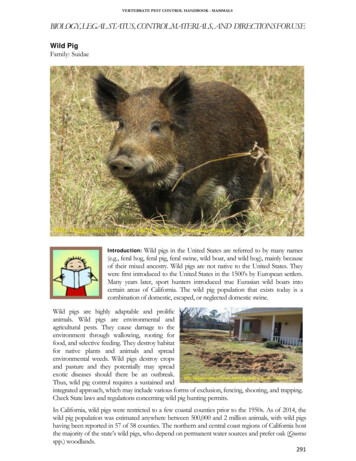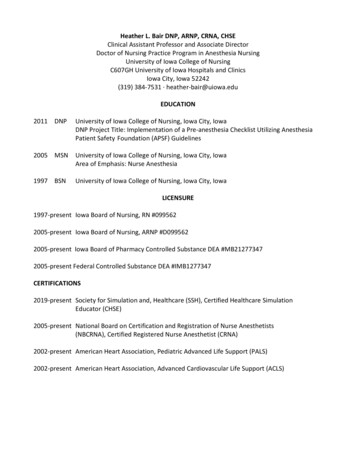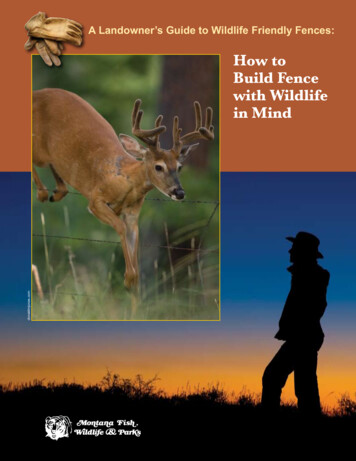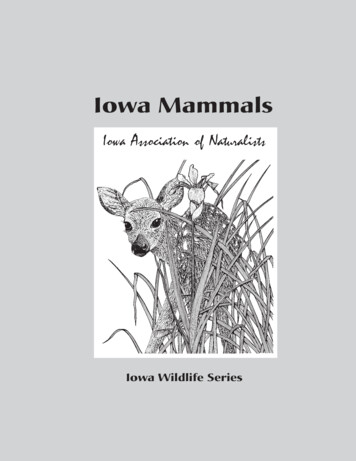
Transcription
Iowa MammalsIowa Association of NaturalistsIowa Wildlife Series
Iowa Association of NaturalistsThe Iowa Association of Naturalists (IAN) is a nonprofit organization ofpeople interested in promoting the development of skills and educationwithin the art of interpreting the natural and cultural environment. IANwas founded in 1978 and may be contacted by writing the ConservationEducation Center, 2473 160th Rd., Guthrie Center, IA 50115, 515/747-8383.Iowa Wildlife SeriesStudents need to be knowledgeable about and appreciate local wildlife in order to better understand thenatural environment. The Iowa Association of Naturalists has created this series of booklets to offer abasic understandable overview of Iowa wildlife. These booklets will assist educators in teaching studentsabout Iowa wildlife. The six booklets in this series are:Iowa Mammals (IAN-601)Iowa Winter Birds (IAN-602)Iowa Nesting Birds (IAN-603)Iowa Reptiles and Amphibians (IAN-604)Iowa Fish (IAN-605)Iowa Insects and Other Invertebrates (IAN-606)The Iowa Wildlife Series is publishedby the Iowa Association of Naturalistswith major funding from the REAPConservation Education Board and theIowa Conservation Education Council(September 1998).Review CommitteeCele Burnett, Consultant, E Resources Group, Inc.Dan Cohen, Naturalist, Buchanan County Conservation BoardDetra Dettmann-Easler, Camp and Program Director, Louisa County Conservation BoardJean Eells, Consultant, E Resources Group, Inc.Judy Levings, State 4-H Youth Development Specialist, Iowa State UniversityJim Pease, Extension Wildlife Specialist, Iowa State UniversityDiane Pixler, Naturalist, Marshall County Conservation BoardA. Jay Winter, Training Officer, Iowa Department of Natural ResourcesEditorial BoardText: Sharon KaufmanIllustrations: Mark MüllerDesign and Layout: Dan Cohen, Writing and Publications ServicesPublished by: Iowa Association of Naturalists
Iowa MammalsIowa MammalsWhat is a mammal?Mammals are among the most interestingand popular of all Earth’sanimals. The term mammalrefers to the female’s mammary glandswhich produce milk to nourish heryoung. The presence of mammaryglands and hair distinguishmammals from otherwarm-blooded, back-boned animals.With some rare but notableexceptions, mammals are hairy andhave teeth. The young are bornalive and are cared for by at leastone parent for an extended period of timeafter birth. The mammalian brain is morecomplex than that of any other animal group.Mammals have lived in North America for about190 million years, appearing shortly after theappearance of the dinosaurs. Their unique abilityto adapt to changing seasons, climates, and foodsources allowed them to survive even through theice ages.Today, mammals live on all continents and in alloceans. They are adapted to an incredible varietyof lifestyles and habitats. Mammals can fly, glide,run, jump, crawl, swim, burrow, and dive.Worldwide, they range in size from the two-inch,1/14- ounce bumblebee bat to the 100-foot, 115-tonblue whale. Their adaptations for survival havemade them successful and dominant amongIowa Association of Naturalists1
Iowa MammalsMammals vary greatly insize as shown in this scaledrawing of a gray whale,person, and brown bat.The carnivore skull(top) is equippedwith canine teethand sheeringmolars, while theherbivore skull(bottom) has sharpfront teeth forcutting vegetation.Earth’s life forms.And it is possiblethat humans, themost adaptable,complex, and successful of themammals, are the ones in whose hands the qualityof the environment and the survival of all otherspecies may be held.Mammalian teeth are among the most specializedin the animal kingdom. The size, shape, andarrangement of teeth not only help determine themammal’s diet but also often may be used toidentify the particular species of mammal. Mostmammals are born with baby teeth called milkteeth which eventually are replaced by permanentteeth. In general, mammals which are primarilyplant-eaters or herbivores have sharp, front teethfor cutting vegetation and back teeth with broad,flat surfaces for grinding the food prior toswallowing. The diet of carnivores consistsprimarily, although not entirely, ofmeat. Therefore, carnivores havesharp canine teeth, often calledfangs, for grabbing and tearing theflesh of other animals. Omnivoresare animals with a varied diet thatincludes both plant and animal material.Omnivores have patterns of teeth withcharacteristics of both herbivores andcarnivores.Mammals can be active at any time of the day andyear. Many wild mammals must hunt withoutbeing detected by the prey they hunt. Thehunters are called predators and often avoidmid-day hours for that reason. Night-activemammals are called nocturnal, while mammalsactive during the day are called diurnal.Mammals that are most active at dawn and duskare called crepuscular.2Iowa Association of Naturalists
Iowa MammalsFamilies of mammals living in IowaThe combination of physical characteristics, specialadaptations for survival, and unique behaviors areused to distinguish the families and species ofmammals from one another.The pouched mammals: marsupialsThe pouched mammals, or marsupials, aresometimes referred to as primitive. Thissimply describes the complexity and efficiencyof some of their physical and behavioraladaptations. It does not mean they are any lesssuccessful. In fact, Iowa’s only marsupial, theopossum, is among the few mammals increasingtheir numbers and expanding their range.Opossums, which are nocturnal, are foundthroughout the Iowa in woodlands and nearwaterways.OpossumIn addition to the pouch in which newly-born animals find protection and nourishment, opossumshave 50 very similar teeth, furless ears and tail,and a prehensile tail. The prehensile tail isunusually strong and muscular and can be usedalmost as another limb. Unlike what is oftenportrayed in nature movies, however, opossums donot hang by their tails.The insect-eating mammals—insectivoresMoles and shrews make up the familyof mammals known asinsectivores, or insect-eaters.These animals generally live ingrass, woodlands, and otherIowa Association of NaturalistsEastern mole3
Iowa Mammalsareas with deep, loose soils. Their teeth are nothighly specialized and usually have just one cusp,or point at the top. The insect-eaters have smalleyes but a very sensitive sense of touch. They areall predators and capable of burrowing throughthe soil in search of their prey. Moles hunt grubsand soil insects. They have thick fur and forelimbsadapted to digging through the soil to find theirfood. Shrews hunt worms, snails, spiders, andinsects. Shrews often have a poison in their salivawhich is believed to help them kill prey nearly asbig as the shrew itself. Their metabolic rates areso high that they must eat almost constantly tosustain themselves.The eastern mole, the star-nosed mole, maskedshrew, pygmy shrew, least shrew, and short-tailedshrew are found throughout Iowa. The status ofthe star-nosed mole and least shrew is unreliableand uncertain. It is possible that they do survivein undisturbed areas of moist, woodland habitat.The gnawing mammals—RodentsRodents characteristically have only twoincisors, or front teeth, and no canine teeth. Theincisors of the upper jaw are especially largeand chisel-shaped. The lack of canine teethresults in an open space called a diastemabetween the incisors and molars in both theupper and lower jaws.Beaver4In both numbers of species and numbers ofanimals, rodents are the most numerous ofIowa’s wild mammals. Their numbers,combined with their ability to producemany young in a short period of time,make them an abundant and stable preyfor many species of predators. Members of the rodent family found commonly throughout Iowa are listed here.Iowa Association of Naturalists
Iowa MammalsCommon rodents found throughout IowaCommon nameWhite-footed mouseDistinguishing characteristicsBrown back; white belly and feetDeer mouseBrown back; white belly and feet; tail sharply bicolored;top brown and bottom whiteSouthern bog lemmingShort tail; brownish-gray furPrairie voleGray back; yellowish belly; shorter tail and nosethan a mouseMeadow voleGray back; silver belly; shorter tail and nose than a mouseMeadow jumping mouseTail much longer than body; big feet; brown back;yellow sides; white bellyWestern harvest mouseWhite feet; yellowish-brown furHouse mouseNaked, scaly tail; grayish both back and belly; not nativeto Iowa; found close to human habitationsNorway ratGrizzled fur; naked and scaly tail; found close to humanhabitations; not native to IowaThirteen-linedground squirrelMany alternating solid and broken lines on back; commonin short grass, golf courses, and roadsidesFranklin’s ground squirrelMottled gray fur; found in taller grassesEastern chipmunkLong tail; facial stripe; two to four dark stripes on backFox squirrelBushy tail with orange-tipped hairs;Iowa’s largest squirrelGray squirrelBushy tail with gray hairsWoodchuckHeavy body; dark feet; dark bushy tail;also called groundhogPlains pocket gopherHeavy body; stumpy tail; big front claws;external cheek pouchesMuskratLong, naked tail which is flattened side to side;dense brown fur; aquatic; builds lodge of cattails andgrasses or a hole in the bankBeaverNaked tail which is flattened top to bottom; dense brownfur; larger than muskrat; aquatic; builds lodge of treesand sticks or a hole in the bankGray squirrelLength: 8-10”Franklin’s ground squirrelLength: 8-10”Iowa Association of NaturalistsThirteen-linedground squirrelLength: 4-6”Fox squirrelLength: 10-15”5
Iowa MammalsLess common rodents found in IowaNameRed squirrelDistinguishing characteristicsSmaller than other squirrels;red above; white below;becoming more rareStatusFound in northcentraland northeastIowa forestsSouthern flyingsquirrelBushy tail; large membranebetween front and hind legs;Southeast 2/3 of state;rare; sensitive toloss of woodlandsWoodland voleShort tail; hard to distinguishfrom prairie voleEndangered; needsold, wet woodlandsRed-backed voleReddish fur on back; shorttail; ears not noticeableEndangered; needswet woods and bogsGrasshopper mouseShort, stocky, prairie dweller;very plush furEndangered;Northwest Iowa onlyRabbits and hares: lagomorphsWild rabbits resemble rodents at first glancebecause, like rodents, they have a pair of large,chisel-like front teeth and no canines. As withrodents, the lack of canine teeth creates a spacecalled a diastema. However, a pair of small,inconspicuous incisors immediately behind thefront incisors is one feature that distinguishesrabbits from rodents.Two species of rabbits live in Iowa - the easterncottontail rabbit and white-tailed jackrabbit. Thewhite-tailed jackrabbit is actually not a rabbit buta hare. It is locally common mainly in westernand northern Iowa. Both rabbits and haresmake their living by eating a variety ofplant material. The primary differencebetween rabbits and hares is that rabbitsgive birth to blind, nearly-naked young,while hares give birth to young who arefully covered with fur and have open eyes.Distinguishing between these two species6Iowa Association of Naturalists
Iowa Mammalsis relatively easy. The much more common easterncottontail rabbit is brownish-gray throughout theyear. Its ears are less than three inches in lengthand its hind feet are less than four and one-halfinches in length. The white-tailed jackrabbit hasmuch longer ears and feet and has awinter coat of nearly pure white forcamouflage in the snow. Its large feetallow it to flee predators quickly in winter by acting like snowshoes.The flying mammals: batsThe only true flying mammals in Iowa arebats. Bats have expansive membranesconnecting their forearms and fingers withthe sides of their bodies and their hindlimbs. In many species, this thin membrane extends to the rear and includes thetail. Rather than gliding under the influence ofgravity, as flying squirrels do, bats truly fly.Usually bats fly at night, late evening, and earlymorning. They find their way and their preythrough the use of echolocation - a sonar-likesystem of sending clicking sounds and listening forthe echo.There is probably no group of animals more fearedand misunderstood than bats. Contrary to myth,bats do not dive in your hair, bite your neck, suckyour blood, or carry off small children. Althoughsome do not see well, bats are not blind. There arevampire bats, but they prey mostly on cow’s bloodand are found only in South America - not in Iowa.Iowa bats are the size of a mouse or smaller andweigh about half an ounce.In Iowa, bats’ most important contribution to theenvironment and our well-being and comfort is theIowa Association of Naturalists7
Iowa Mammalsfact that they eat lots of insects. A single bat iscapable of eating up to 2,000 mosquitoes on awarm, summer Iowa evening. Bat populations aredeclining statewide for a variety of reasons. Use ofchemical pesticides to kill insects has reducedtheir available food. And loss of woodlands andincreased human traffic in caves have decreasedthe availability of suitable shelter.There are nine species of bats known in Iowa.Some can be difficult to identify.Common bats found throughout IowaCommon nameLittle brown myotisDistinguishing characteristicsAbout one-half the size of a mouse; chocolate-brownfur; no fur on wings; weighs about 1/4 ounce;hibernates in caves and unheated attics in the winterBig brown batMouse-sized; bronzy-brown fur; naked wings and tail;found more often in attics, chimneys, and hollow treesRed batWing and tail membranes heavily furred;reddish-orange fur; roosts in trees and woodland areasHoary batWing and tail membranes heavily furred; furyellow-brown with white tips; roosts in treesSilver-haired batWing membranes heavily furred especially near tail;fur has a silver-colored tint; prefers woodlandsLess common bats found in Iowa8Common nameIndiana batDistinguishing characteristicsStatusHard to tell from other small bats; bellyEndangeredfur pinkish-gray at tips; hibernates incaves in winter; spends Iowa summers ingroups often under the loose bark of old treesEastern pipistrelleOne-half the size of a mouse; yellow-brownfur; dark reddish-brown wings; each strandof fur distinctly tricoloredEvening batChocolate-brown like big brown bat but much Threatened;smaller; very small ears; found in atticssoutheast 1/3 ofIowa; summer onlyKeen’s myotisChocolate-brown like little brown myotis but Threatened;with much longer ears; found in cavessoutheast 1/4 of IowaFound in eastern3/4 of IowaIowa Association of Naturalists
Iowa MammalsThe flesh-eating mammals: carnivoresThe flesh-eating mammals, or carnivores, areboth among our most favorite andleast favorite animals. Someviews of carnivores show them tobe cute and cuddly, particularlywhen they are young. Other viewsportray them as ruthless, rabidkillers. In fact, neither view isaccurate. Carnivores are adaptedto a diet consisting mostly of meat,so they have long, sharp canineteeth for tearing their food. Manycarnivores are predators whichactively hunt prey. Others arescavengers, eating animalswhich have died in someother way.Red foxWe often have difficulty separating themyths and stories about carnivores from reality.Hence, Wile E. Coyote, the Big Bad Wolf, and theThree Bears (of Goldilocks fame) are given anunfairly bad reputation, while Bambi is oftenprotected, at all cost, as the unwary victim.Like humans, carnivores need food, clean water,suitable shelter, and enough space in which to live.Larger predators need large spaces in which tohunt and, in general, have not adapted well to thefragmentation of their habitat by urban sprawl andagricultural practices. Like humans, carnivoreshave fewer young. These young require a longerperiod of care by the parents. Carnivores areknown to be instinctively good parents and verycaring and defensive of their young.Iowa Association of Naturalists9
Iowa MammalsCoyoteCommon carnivores found throughout IowaCommon nameCoyoteDistinguishing characteristicsThe weight of a medium-sized dog; bushy tail; coarserusty-colored fur; tail tip darkRed foxThe weight of a large cat; long, soft rusty-colored fur above;whitish fur on belly; fluffy tailGray foxSimilar in size to a red fox; long, soft rusty-colored fur on legsand ears; grizzled gray fur on back; climbs treesRaccoonCharacteristic mask; long tail alternately banded with black;grizzled black and brown furLeast weaselAt only six inches, it is the smallest carnivore; short tailwithout a black tip; chocolate-brown back in summer; whitein winter; white feetMinkWeight comparable to a small cat; chocolate-brown fur withwhite chin; typical long and flexible weasel-shaped bodyBadgerLarge, heavy-bodied member of the weasel family; whitestripe on head; large forefeet with long claws for burrowingStriped skunkBlack fur with one or two long white stripes; known for usingscent glands under tail as a defense when threatenedLess common carnivores found in IowaCommon nameBobcatDistinguishing characteristicsSharp, retractable claws; tan torusty fur but with dark streaks andspots; tufts on ears; very secretiveStatusUncommon butfound in suitablewoodland habitatSpotted skunkAlso known as civet cat; black withwhite broken markingsOnce common butdeclining statewideRiver otterLarge, dark, weasel-shaped body;small ears; webbed feetReintroduced inselect locationsErmineAlso known as short-tailed weasel;brown in summer; white in winterwith black-tipped tail and white feetRare; only found innortheast half of Iowa;status undeterminedLong-tailed weaselSimilar in color but slightly largerthan ermine; without white feetRare but foundthroughout Iowa10Iowa Association of Naturalists
Iowa MammalsThe hoofed mammals: ungulatesAll mammals have claws or toenails composedof a protein-like substance called chitin. Thehoofed mammals have either one or twoprominent, large toes upon which they walk orrun. The other toes may be present, but theyare reduced in size and inconspicuous.There are two large subgroups of hoofedmammals - even-toed hoofed mammals andodd-toed hoofed mammals.Odd-toed hoofed mammals walk on a single,central front toe. Examples of odd-toed, hoofedmammals are the horse and rhinoceros. There areno wild, odd-toed hoofed mammals found in Iowa.The even-toed hoofed mammals walk on twoprominent toes. The commonly recognized track ofthe white-tailed deer demonstrates thischaracteristic. Members of this family found inIowa include such livestock animals as cattle, pigs,sheep, and goats. Although numbers of livestockanimals in Iowa are higher even than humannumbers, discussion here will be limited toIowa’s wild, even-toed hoofed mammals. Theonly wild member of this family still livingwild in the state is the white-tailed deer. Elk,moose, and bison are even-toed hoofed mammals that no longer live in the wild in Iowa.White-tailed deerbuckThe white-tailed deer is among the mostrecognizable and important species of wildmammals in Iowa. It is the only hoofedmammal common throughout the state.White-tailed deer adapt well to edges betweennatural communities and edges of towns andfarms created by human habitation. Deernumbers generally are increasing, especiallyIowa Association of Naturalists11
Iowa MammalsWhite-tailed deerdoenear agricultural and residential areas. Thesame myths, misconceptions, and lack ofunderstanding that perpetuate fear and hatredof predators also create tension among Iowa’shunters, farmers, homeowners, and wildlifeenthusiasts.Prior to the European settlement of Iowa,white-tailed deer were common. Due touncontrolled market hunting, deer werecompletely eliminated from the state by 1900.Today, white-tailed deer have been restored toIowa. Hunting and other measures are used toactively manage deer populations.Unique adaptations to life in IowaPrior to settlement, Iowa wasmostly tallgrass prairie. Therewere extensive wetlands andwet prairies in thenorth-central part of the stateand woodlands along itsnumerous waterways. Withsettlement, most of the prairieand wetlands were destroyed.It’s possible that Iowa has justas many trees as it did prior tosettlement. However, ouroriginal extensive, contiguousacres of woodlands have beenfragmented by agriculturalpractices and urbandevelopment. These changeshave had enormous impacts onIowa’s ecosystems.12Iowa Association of Naturalists
Iowa MammalsThe changes should not be considered all bad.Certainly, our agricultural industry is the mostimportant component of the Iowa economy andthese changes have made it possible forhundreds of thousands of people to make aliving in the state. There have beentrade-offs, however, including changes inthe populations of Iowa’s mammals.One thing that has notchanged significantly inthe past few hundredyears is Iowa’sclimate. Iowastill enjoysincredibleseasonalchanges, fromhot and humidin the summerto snowy andcold in the winter. Mammals still living in Iowahave had to adapt to the presence of humans,develop diets composed of many different foods,and tolerate extreme changes in the weather.Chipmunks, squirrels, coyotes, and raccoonshave adapted well to Iowa woodlands.Their darker coloration camouflages amongthe shadows. They have comparativelysmall home ranges, so they are able totolerate forest fragmentation. Their broadrange of foods and ability to helpthemselves at birdfeeders, fields ofagricultural crops, and backyard wildlifeplantings help them survive.Iowa Association of NaturalistsEastern chipmunk13
Iowa MammalsHibernating woodchuckHibernation is oneof many adaptationsto the cold anddecreased foodsupplies of Iowawinters. Mostmammals, includingpeople, tend to slowdown a little duringthe winter. Truehibernators actually curl into a tight ball andreduce to extremely low levels their heart andbreathing rates, body temperature, andmetabolism. They need less food to survive. Batswhich eat insects have virtually nothing availableto eat so they are forced to hibernate all winter.Other hibernators include woodchucks, groundsquirrels, jumping mice, and a few other rodents.There are a number of mammals such as badgers,raccoons, chipmunks, and skunks which do nottruly hibernate. They do, however, reduce theirneed for food by sleeping deeply for periodsextending from a few days to two weeks.Mice and voles are among the most abundantinhabitants of Iowa’s fields and prairies. Most eata variety of seeds and other plant materials. Theirability to create tunnels and runways through theseasons-old grasses near the ground allow them tocache food for the winter and escape voraciouspredators.River otter14All mammals need water, and many Iowamammals live in or near waterways. Iowa’swater-loving mammals have uniquely thick andwaterproof fur. This pelt insulates such animalsas mink, otter, beaver, andmuskrat. The thick fur of theseanimals often has relatively higheconomic value. One example isthe river otter. Otters wereIowa Association of Naturalists
Iowa Mammalstrapped to extirpation from Iowa’s interiorwaterways because of their pelts. Their sleekbodies and webbed feet allowed them tosuccessfully escape their natural predators, butthey were no help in avoiding traps. Partnershipsamong several agencies and organizations havehelped reintroduce river otters to Iowa’s waterwaysto the delight of many Iowans lucky enough tocatch a glimpse of these marvelous creatures.Mammals as nuisances?If Iowa’s wildlife biologists weresurveyed to determine the mostcommonly-requested information,it surely would be wildlifenuisance problems. The wordnuisance is an opinion. It is nota fact of ecology. We tend toconsider certain animalsnuisances when they interactwith people in ways we eitherdon’t like or considerdangerous.Moles dig up our lawns. Deer and ground squirrelsdamage agricultural crops. Beavers build damsthat flood land we don’t want flooded. Rabbits andwoodchucks invade our gardens. And bats spendthe winter in our attics. These are among the mostcommon wildlife nuisances. Damage toagricultural crops is a significant economicproblem, and the threat of rabies is not just anuisance but a real danger to our health. Mostnuisances, however, are just nuisances. Whenexamined carefully, most can be avoided or simplytolerated.Iowa Association of Naturalists15
Iowa MammalsBats sometimes roost inattics or other places wherepeople do not want them.All animals need food, water, shelter,and space. When an animalbecomes a nuisance, it’s simplytrying to survive - sometimes inways and places we don’tlike. An attic may look justlike the inside of a largetree, a perfect place for abat to roost or hibernate.Pet food on the kitchenfloor may become aspecial treat for a deermouse which found itsway inside while escapingthe first autumn frost. Andgarden vegetables are abundant andnutritious - not just for people.While the nuisance activity of wildlife should beconsidered natural, that does not mean we have toaccept the nuisance. Solving the problemsuccessfully requires that we examine the problemand carefully consider possible solutions.Generally speaking, the use of poisons should be alast resort. Most poisons don’t work on just onespecies, and accidentally harming people,household pets, and animals we do like is possible.Rather than using poisons, consider removingaccess to the food and shelter they seek. Openingsunder the eaves or pipes entering the house areinvitations to any animal that is looking forshelter. The solution is to close the openings. Petfood or garbage left in an accessible location is aninvitation to any hungry animal. The solution isto clean it up, cover it, and don’t give your petmore food than it can eat in one feeding. Onesolution to deer, rabbits, and woodchucks eatinggarden vegetables is to fence them out of gardenareas.16Iowa Association of Naturalists
Iowa MammalsThere are numerous other nuisance wildlifesituations and solutions. State, county, andextension wildlife biologists are well-prepared withobjective research data, good information, andreasonable suggestions for solving your problems.Economic impact of Iowa mammalsRodents are of great economic importance in Iowa.Woodchucks, pocket gophers, ground squirrels, andchipmunks cause significant damage to field cropsand gardens. Mice and voles cause considerableloss annually to orchards and tree nurseries bygirdling young trees, particularly during thewinter. Damage caused by the non-native Norwayrat and efforts to control its infestation totalmillions of dollars annually.On the positive side of the economic coin arebeaver, muskrats, and other furbearers which aretrapped for their fur. Burrowing by groundsquirrels, voles, and mice improves soil aerationand productivity. And the burrows of manyrodents are used in turn by a variety of otheranimals for shelter.The deer hunting industry in Iowa has incredibleeconomic impact in this state. While increasingnumbers of deer can be positive for wildlifewatchers and deer hunters, tremendous damage tonatural vegetation and agricultural crops causedby high deer populations has been documented.Iowa Association of Naturalists17
Iowa MammalsThe economic benefits of healthy wildlifepopulations are significant. Tourism and theresulting economic impacts from wildlife watchingby non-hunters and purchase of licenses andequipment by hunters are tremendous. Inaddition, efforts to improve urban and backyardhabitat and wildlife habitat on privately-ownedlands have made a positive economic impact onsuch businesses as nurseries and sources fornative grass seed. These same efforts do not justimprove habitat for Iowa’s mammals but alsoIowa’s birds, butterflies, insects, fish, amphibians,reptiles, and all the other creatures with whom weshare the natural world.Wildlife protection and managementPeople continually learn more abouthow to manage wildlife habitat toimprove biodiversity, to reducenuisances, to favor animals whosepopulations we would like to expand, andto protect our most vulnerable species.Aldo Leopold18Interestingly enough, the individualoften considered the Father ofWildlife Management - AldoLeopold - was born in Iowa and did his firststatewide game survey here. Leopold devotedmuch of his career to understanding not only thehabitat needs of specific animals but also howthose needs interacted and overlapped in a healthynatural community. Many currently accepted andapplied wildlife management practices are directlyattributable to Leopold’s work.Iowa Association of Naturalists
Iowa MammalsIn its early years, the science of wildlifemanagement was focused primarily on increasingpopulations of game species. This was, in part, dueto the fact that most of the work was conductedusing hunting license revenues. Hunting licensefees still fund most wildlife management work andhunters deserve the credit. However, research,better understanding of individual species, andadvancements in the science of ecology haveresulted in a broader view of the goals of wildlifemanagement. One lesson learned from AldoLeopold is that wildlife managers can’t have justone goal, so wildlife managers today workdiligently toward several goals, including habitathealth, environmental quality, and wildlifediversity. This approach results in healthier, moresustainable populations of both game and nongamespecies.Wildlife protection and managementWhether caused by the loss of suitablehabitat or by a global disaster such as acomet impact, extinction is thecomplete disappearance of an entire species.There are several species of mammals once foundin Iowa which have become extinct, including thegiant ground sloth, giant beaver, Americanmastodon, mammoth, and giant bison. Manyextinct mammals were ice age mammals that didnot survive the transition to a warmer, temperateclimate. Extinction is natural, but the rate ofextinction has increased tremendously since peoplehave begun to alter natural ecosystems.Iowa Association of Naturalists19
Iowa MammalsIowa Extirpated species arethose that were once found inIowa, but no longer have breedin
adaptations for survival, and unique behaviors are used to distinguish the families and species of mammals from one another. The pouched mammals: marsupials The pouched mammals, or marsupials, are sometimes referred to as primitive. This simply describes the complexity and efficiency of some of their physical and behavioral adaptations.
